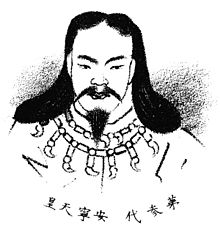Annei

Annei ( Japanese 安寧 天皇 Annei-tennō ; * 577 BC ; † 511 BC ) was the 3rd Tenno of Japan (549 BC – 511 BC ) according to the ancient chronicles of Kojiki and Nihonshoki . . Its historical existence is doubtful. He is one of the "eight undocumented emperors" ( 欠 史 八 代kesshi hachidai ) of whom only a sketchy representation is known.
His proper name was Shiki-tsu-hiko-tama-temi no mikoto (Nihonshoki (N): 磯 城 津 彦 玉手 看 尊 , Kojiki (K): 師 木 津 日子 玉手 見 命 ). According to the Nihonshoki, his mother was Isuzu-yori-hime no mikoto ( 五十鈴 依 媛 命 ), according to the Kawa-mata-hime ( 河 俣 毘 売 ). On the 7th day of the 1st lunar month in the 25th year of his father Suizei's reign (557 BC) he was appointed Crown Prince and took over after his death two months later on the 3rd day of the 7th lunar month in his 33rd year of reign (549 BC) BC) the throne.
Annei ruled in the Ukiana palace (N: 片 塩 浮 孔 宮 , K: 片 塩 浮 穴 宮 , Katashio no Ukiana no miya ) in Katashio (probably in today's Yamatotakada ). According to the Nihonshoki, his wife was Nuna-soko-naka-tsu-hime no mikoto ( 渟 名 底 仲 媛 命 ), according to the Kojiki Akuto-hime ( 阿 久 斗 比 売 ). The Nihonshoki gives two sources for his sons, which are either Okiso-mimi no mikoto ( 息 石耳 命 ) and O-yamato-hiko-suki-tomo no mikoto ( 大 日本 彦 耜 友 尊 ) or as in Kojiki Toko-tsu -hiko-iro-ne (N: 常 津 彦 某 兄 , K: 常 根 津 日子 伊呂 泥 命 , ~ no mikoto ), Ō-yamato-hiko-suki-tomo (N: 大 日本 彦 耜 友 , K: 大 倭 日子 鉏 友 命 , ~ no mikoto ) and Shiki-tsu-hiko no mikoto (N: 磯 城 津 彦 命 , K: 師 木 津 日子 命 , ~ no mikoto ) were.
He died after the Nihonshoki at the age of 67 on the 6th day of the 12th lunar month in his 38th year of reign (511 BC), after the Kojiki at the age of 49. His mausoleum ( misasagi ) is the tumulus Unebi-yama-no-hitsujisaru-no-mihodo-no-i-no-e-no-misasagi ( 畝 傍山 西南 御 陰 井上 陵 , 'Imperial tomb on the well / the source of benevolence southwest of Mount Unebi '; 34 ° 29 ′ 24 ″ N , 135 ° 46 ′ 42 ″ E ) in Kashihara . His successor was his second son O-yamato-hiko-suki-tomo.
The name Annei, the two characters of which mean 'peaceful, calm', was given later when the Japanese emperors began to give themselves Chinese, often Buddhist-inspired names.
Remarks
- ↑ The Nihonshoki gives the age 57 years, but also states that he became crown prince at the age of 21, became emperor after eight years and ruled for 38 years, which makes a total of 67 years. The Japanese copy gives the conversion of the year of death of the metal tiger 516 BC. In fact, the year of the Metal Tiger was 511 BC. Chr.
Individual evidence
- ^ A b c d e William George Aston: Nihongi: Chronicles of Japan from the Earliest Times to AD 697 . Trench, Trübner & Co., London 1896, p. 141–142 ( Textarchiv - Internet Archive ). ; Copy of Nihonshoki (Japanese)
- ↑ a b c d e Basil Hall Chamberlain: The Kojiki . 1919, Section LVI. - Emperor An-nei ( sacred-texts.com ).
- ↑ 天 皇陵 - 安寧 天皇 畝 傍山 西南 御 陰 井上 陵 . Kunai-chō , accessed October 2, 2017 (Japanese).
| predecessor | Office | successor |
|---|---|---|
| Suicide |
Tennō 549-511 BC Chr. |
Itoku |
| personal data | |
|---|---|
| SURNAME | Annei |
| ALTERNATIVE NAMES | 安寧 天皇 (Japanese) |
| BRIEF DESCRIPTION | 3. Tennō of Japan (549-511 BC) |
| DATE OF BIRTH | 577 BC Chr. |
| DATE OF DEATH | 511 BC Chr. |
